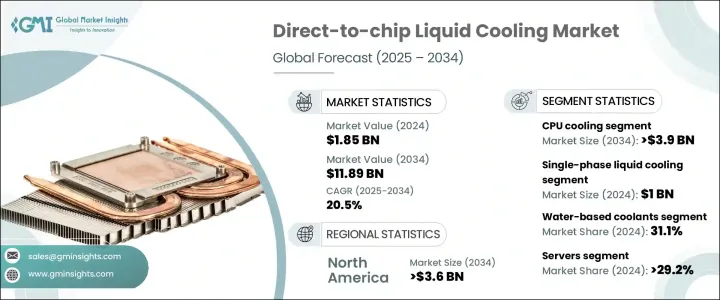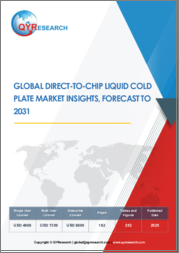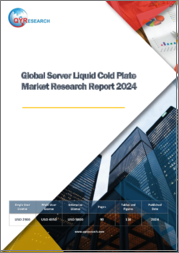
|
시장보고서
상품코드
1699319
다이렉트 칩 액체 냉각 시장 기회, 성장 촉진요인, 산업 동향 분석, 예측(2025-2034년)Direct-to-chip Liquid Cooling Market Opportunity, Growth Drivers, Industry Trend Analysis, and Forecast 2025-2034 |
||||||
세계의 다이렉트 칩 액체 냉각 시장은 2024년에 18억 5,000만 달러로 평가되었고 기업이 고성능 컴퓨팅, 에너지 효율, 지속 가능한 데이터센터 솔루션을 우선하는 경향이 커지는 가운데 2025년부터 2034년에 걸쳐 CAGR 20.5%를 나타낼 전망입니다.
인공지능(AI), 머신러닝(ML), 클라우드 컴퓨팅의 급속한 보급으로 데이터 처리 수요가 전례 없이 급증하고 있으며, 종래의 냉각 방법으로는 고급 프로세서의 열부하 상승을 관리하는 것이 어려워지고 있습니다.

고성능 컴퓨팅(HPC) 환경이 처리 능력의 한계를 넓히는 가운데, 종래의 공냉 방식에서는 CPU, GPU, 메모리 모듈의 방열 요구에 대응하는데 어려움을 겪고 있습니다. - 클라우드 서비스 제공업체, 하이퍼스케일 데이터센터, AI 주도 워크로드를 구축하는 기업은 액체 냉각 기술을 통합하여 효율성을 극대화하고 운영 비용을 최소화하고 있습니다.
| 시장 규모 | |
|---|---|
| 시작 연도 | 2024년 |
| 예측 연도 | 2025-2034년 |
| 시작 금액 | 18억 5,000만 달러 |
| 예측 금액 | 118억 9,000만 달러 |
| CAGR | 20.5% |
이 시장은 GPU 냉각, CPU 냉각, 메모리 냉각, ASIC 냉각 및 기타 구성 요소별 솔루션으로 구분됩니다. 첨단 CPU는 상당한 열 부하를 발생시키기 때문에 시스템의 안정성을 유지하고 성능 저하를 방지하기 위해 최첨단 열 관리 솔루션이 필요합니다.
시장은 또한 수성 냉각재, 유전류체, 미네랄 오일, 인공유체 등 액체 냉각재의 유형에 따라 분류됩니다. 기업이 지속 가능성에 초점을 맞추면서 이러한 냉각수는 고성능 표준을 유지하면서 에너지 소비를 줄이는 데 선호되는 선택이 되고 있습니다.
북미는 다이렉트 칩 액체 냉각 시장을 석권해 2034년까지 36억 달러 시장 규모에 이를 것으로 예측되고 있습니다. 데이터 인프라에 대한 투자가 급증하고 있으며, 고급 냉각 시스템의 필요성이 높아지고 있습니다.
목차
제1장 조사 방법과 조사 범위
제2장 주요 요약
제3장 업계 인사이트
- 생태계 분석
- 업계에 미치는 영향요인
- 성장 촉진요인
- 고성능 컴퓨팅(HPC) 수요 증가
- 데이터센터의 고밀도화
- 지속가능성에 대한 관심 증가
- 고성능 컴퓨팅 수요 증가
- 데이터센터에서의 에너지 효율과 지속가능성에 대한 주목 향상
- 업계의 잠재적 위험 및 과제
- 높은 초기 투자 비용
- 보수·운용의 복잡성
- 성장 촉진요인
- 성장 가능성 분석
- 규제 상황
- 기술 상황
- 향후 시장 동향
- 갭 분석
- Porter's Five Forces 분석
- PESTEL 분석
제4장 경쟁 구도
- 서론
- 기업 점유율 분석
- 주요 시장 기업의 경쟁 분석
- 경쟁 포지셔닝 매트릭스
- 전략 대시보드
제5장 시장 추계·예측 : 냉각 솔루션 유형별(2021-2034년)
- 주요 동향
- 단상 액체 냉각
- 2상 액체 냉각
제6장 시장 추계·예측 : 구성 요소 냉각별(2021-2034년)
- 주요 동향
- CPU 냉각
- GPU 냉각
- ASIC 냉각
- 메모리 냉각
- 기타 부품 냉각
제7장 시장 추계·예측 : 액체 냉각재 유형별(2021-2034년)
- 주요 동향
- 수성 냉각재
- 유전체 유체
- 광유
- 엔지니어드 유체
제8장 시장 추계·예측 : 용도별(2021-2034년)
- 주요 동향
- 서버
- 워크스테이션
- 엣지 컴퓨팅 디바이스
- 슈퍼컴퓨터
- 게이밍 PC
- 기타
제9장 시장 추계·예측 : 최종 용도별(2021-2034년)
- 주요 동향
- 데이터센터
- 고성능 컴퓨팅(HPC)
- 인공지능/머신러닝 시스템
- 게임 및 e스포츠
- 통신
- 금융 서비스
- 헬스케어 및 생명과학
- 석유 및 가스
- 자동차(전기자동차 배터리)
- 항공우주 및 방위
- 기타
제10장 시장 추계·예측 : 지역별(2021-2034년)
- 주요 동향
- 북미
- 미국
- 캐나다
- 유럽
- 독일
- 영국
- 프랑스
- 스페인
- 이탈리아
- 아시아태평양
- 중국
- 인도
- 일본
- 뉴질랜드
- 한국
- 라틴아메리카
- 브라질
- 멕시코
- 중동 및 아프리카
- 사우디아라비아
- 남아프리카
- 아랍에미리트(UAE)
제11장 기업 프로파일
- Asetek
- Alfa Laval
- Castrol
- Cisco Systems, Inc.
- CoolIT Systems
- DCX The Liquid Cooling Company
- Danfoss A/S
- DUG Technology
- Equinix, Inc.
- Fujitsu Limited
- Green Revolution Cooling(GRC)
- Huawei Technologies Co., Ltd.
- Iceotope Technologies Ltd.
- Inspur Systems
- LiquidCool Solutions
- LiquidStack
- Rittal GmbH &Co. KG
- Schneider Electric
- STULZ GmbH
- Submer Technologies
- Super Micro Computer, Inc.
- Vertiv Group Corp.
- ZutaCore
The Global Direct-To-Chip Liquid Cooling Market, valued at USD 1.85 billion in 2024, is on track to expand at a CAGR of 20.5% from 2025 to 2034 as enterprises increasingly prioritize high-performance computing, energy efficiency, and sustainable data center solutions. The rapid proliferation of artificial intelligence (AI), machine learning (ML), and cloud computing is driving an unprecedented surge in data processing demands, making conventional cooling methods less effective in managing the rising thermal loads of advanced processors. Organizations worldwide are shifting toward direct-to-chip liquid cooling solutions to enhance system reliability, prevent thermal throttling, and optimize power consumption. The growing emphasis on green data centers and carbon footprint reduction further accelerates adoption, positioning liquid cooling as an essential innovation in next-generation computing infrastructure.

As high-performance computing (HPC) environments push the boundaries of processing power, traditional air-based cooling struggles to keep pace with the heat dissipation needs of CPUs, GPUs, and memory modules. Direct-to-chip liquid cooling, which enables precise thermal management by transferring heat directly from the chip to a liquid coolant, is emerging as a game-changer in data center optimization. Cloud service providers, hyperscale data centers, and enterprises deploying AI-driven workloads are integrating liquid cooling technologies to maximize efficiency and minimize operational costs. The demand for real-time data analytics, high-density computing clusters, and 5G infrastructure deployment is further reinforcing the market's expansion.
| Market Scope | |
|---|---|
| Start Year | 2024 |
| Forecast Year | 2025-2034 |
| Start Value | $1.85 Billion |
| Forecast Value | $11.89 Billion |
| CAGR | 20.5% |
Segmented by component cooling, the market encompasses GPU cooling, CPU cooling, memory cooling, ASIC cooling, and other component-specific solutions. The CPU cooling segment is projected to reach USD 3.9 billion by 2034, driven by the widespread adoption of AI and cloud-based applications that significantly increase processor power consumption. Advanced CPUs generate substantial heat loads, requiring cutting-edge thermal management solutions to maintain system stability and prevent performance degradation. Direct-to-chip liquid cooling delivers superior heat dissipation, ensuring sustained performance even under extreme computational workloads.
The market is also categorized by liquid coolant type, including water-based coolants, dielectric fluids, mineral oils, and engineered fluids. Water-based coolants, which held a 31.1% market share in 2024, are gaining traction due to their exceptional thermal conductivity and cost-effectiveness. As enterprises focus on sustainability, these coolants are becoming a preferred choice for reducing energy consumption while maintaining high-performance standards. Their superior heat transfer properties make them an ideal solution for modern data centers striving to balance efficiency and environmental responsibility.
North America is set to dominate the direct-to-chip liquid cooling market, with projections indicating a valuation of USD 3.6 billion by 2034. The region's rapid data center expansion, growing cloud computing ecosystem, and escalating demand for HPC solutions are driving widespread adoption. The United States, which held a commanding 78.4% market share in 2024, is witnessing soaring investments in data infrastructure, fueling the need for advanced cooling systems. With AI-driven applications and hyperscale cloud services pushing the limits of computing power, the demand for high-efficiency thermal management solutions continues to surge, reinforcing the U.S. market's leadership in the evolving data center landscape.
Table of Contents
Chapter 1 Methodology and Scope
- 1.1 Market scope and definitions
- 1.2 Research design
- 1.2.1 Research approach
- 1.2.2 Data collection methods
- 1.3 Base estimates and calculations
- 1.3.1 Base year calculation
- 1.3.2 Key trends for market estimation
- 1.4 Forecast model
- 1.5 Primary research and validation
- 1.5.1 Primary sources
- 1.5.2 Data mining sources
Chapter 2 Executive Summary
- 2.1 Industry 3600 synopsis
Chapter 3 Industry Insights
- 3.1 Industry ecosystem analysis
- 3.2 Industry impact forces
- 3.2.1 Growth drivers
- 3.2.1.1 Rising demand for high-performance computing (HPC)
- 3.2.1.2 Increasing data center density
- 3.2.1.3 Increased focus on sustainability
- 3.2.1.4 Rising demand for high-performance computing
- 3.2.1.5 Growing focus on energy efficiency and sustainability in data centers
- 3.2.2 Industry pitfalls and challenges
- 3.2.2.1 High initial investment costs
- 3.2.2.2 Complexity of maintenance and operations
- 3.2.1 Growth drivers
- 3.3 Growth potential analysis
- 3.4 Regulatory landscape
- 3.5 Technology landscape
- 3.6 Future market trends
- 3.7 Gap analysis
- 3.8 Porter's analysis
- 3.9 PESTEL analysis
Chapter 4 Competitive Landscape, 2024
- 4.1 Introduction
- 4.2 Company market share analysis
- 4.3 Competitive analysis of major market players
- 4.4 Competitive positioning matrix
- 4.5 Strategy dashboard
Chapter 5 Market Estimates and Forecast, By Cooling Solution Type, 2021 – 2034 (USD Mn)
- 5.1 Key trends
- 5.2 Single-phase liquid cooling
- 5.3 Two-phase liquid cooling
Chapter 6 Market Estimates and Forecast, By Component Cooling, 2021 – 2034 (USD Mn)
- 6.1 Key trends
- 6.2 CPU cooling
- 6.3 GPU cooling
- 6.4 ASIC cooling
- 6.5 Memory cooling
- 6.6 Other component cooling
Chapter 7 Market Estimates and Forecast, By Liquid Coolant Type, 2021 – 2034 (USD Bn)
- 7.1 Key trends
- 7.2 Water-based coolants
- 7.3 Dielectric fluids
- 7.4 Mineral oils
- 7.5 Engineered fluids
Chapter 8 Market Estimates and Forecast, By Application, 2021 – 2034 (USD Bn)
- 8.1 Key trends
- 8.2 Servers
- 8.3 Workstations
- 8.4 Edge computing devices
- 8.5 Supercomputers
- 8.6 Gaming PCs
- 8.7 Others
Chapter 9 Market Estimates and Forecast, By End Use, 2021 – 2034 (USD Bn)
- 9.1 Key trends
- 9.2 Data centers
- 9.3 High-performance computing (HPC)
- 9.4 Artificial intelligence/machine learning systems
- 9.5 Gaming and eSports
- 9.6 Telecommunications
- 9.7 Financial services
- 9.8 Healthcare and life sciences
- 9.9 Oil and gas
- 9.10 Automotive (for electric vehicle batteries)
- 9.11 Aerospace and defense
- 9.12 Others
Chapter 10 Market Estimates and Forecast, By Region, 2021 – 2034 (USD Bn)
- 10.1 Key trends
- 10.2 North America
- 10.2.1 U.S.
- 10.2.2 Canada
- 10.3 Europe
- 10.3.1 Germany
- 10.3.2 UK
- 10.3.3 France
- 10.3.4 Spain
- 10.3.5 Italy
- 10.4 Asia Pacific
- 10.4.1 China
- 10.4.2 India
- 10.4.3 Japan
- 10.4.4 ANZ
- 10.4.5 South Korea
- 10.5 Latin America
- 10.5.1 Brazil
- 10.5.2 Mexico
- 10.6 Middle East and Africa
- 10.6.1 Saudi Arabia
- 10.6.2 South Africa
- 10.6.3 UAE
Chapter 11 Company Profiles
- 11.1 Asetek
- 11.2 Alfa Laval
- 11.3 Castrol
- 11.4 Cisco Systems, Inc.
- 11.5 CoolIT Systems
- 11.6 DCX The Liquid Cooling Company
- 11.7 Danfoss A/S
- 11.8 DUG Technology
- 11.9 Equinix, Inc.
- 11.10 Fujitsu Limited
- 11.11 Green Revolution Cooling (GRC)
- 11.12 Huawei Technologies Co., Ltd.
- 11.13 Iceotope Technologies Ltd.
- 11.14 Inspur Systems
- 11.15 LiquidCool Solutions
- 11.16 LiquidStack
- 11.17 Rittal GmbH & Co. KG
- 11.18 Schneider Electric
- 11.19 STULZ GmbH
- 11.20 Submer Technologies
- 11.21 Super Micro Computer, Inc.
- 11.22 Vertiv Group Corp.
- 11.23 ZutaCore



















